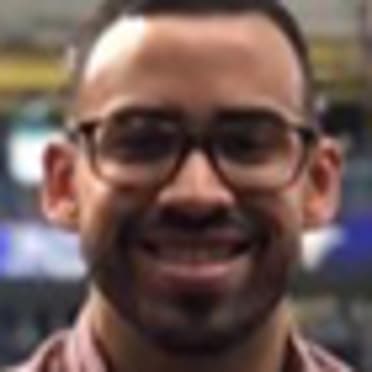Rays' top general manager: Toribio's take
Over the last two months, MLB.com has been breaking down the top five players at each position in Rays history. Some of the decisions were pretty clear -- hi, Evan Longoria -- while others created a good amount of debate on Twitter.
Last week, Joe Maddon was the clear choice to manage the all-time team, therefore it wasn’t necessary to do a top-five list at the manager spot. The same applies for general manager, as it's another easy call for the Rays.
The Rays have had just four general managers in their 22-year history, but Andrew Friedman’s ability to change the culture, establish analytics as a keystone and construct multiple winning teams during his tenure sets him apart in the conversation for Tampa Bay’s top GM.
“I really appreciated the honesty he had with all the players,” former Rays outfielder Jonny Gomes told the Orange County Register. “As a player, you buy into that and feel like you can ask a question and it’s not going to be judged in any way. It’s a really good quality.”
When Stuart Sternberg bought the Rays in 2005, he wanted to do things differently. Despite having some big names on the roster -- though past their primes -- the Rays were unable to finish over .500 in each of the first eight seasons.
After firing Chuck LaMar, the organization’s first GM, Sternberg looked for a replacement that would help the club find creative ways to build a competitive roster, even without the ability to go toe-to-toe with some of the big spenders in free agency. That’s when he looked to Friedman.
It took some time, but Friedman was slowly able to build a competitive team. In January 2006, he acquired Edwin Jackson in a deal with the Dodgers. Around five months later, Friedman and the Rays selected Evan Longoria with the third overall pick in the Draft, followed by Alex Cobb in the fourth round and Desmond Jennings in the 10th round.
Just a few weeks later, Friedman executed a batch of successful trades, accelerating the organization’s momentum. Friedman was able to help the Rays acquire J.P. Howell, Dioner Navarro and Ben Zobrist, all of whom played a major role in the 2008 run to the World Series.
In 2007, Friedman continued to build the Rays’ roster, signing Akinori Iwamura from Japan and taking a chance on Carlos Peña on a Minor League deal. Later that year, Friedman drafted David Price with the No. 1 pick, took Matt Moore in the fourth round and acquired relievers Grant Balfour and Dan Wheeler via trades.
If it sounds like Friedman acquired a lot of talent in just two years, it’s because he did. In fact, he acquired a lot of talent during his nine years with the Rays, picking up 10 players (via the Draft, trades or free-agent signings) who made their first All-Star team with Tampa Bay.
“Andrew is one of the brightest people I’ve ever met,” said former Rays manager Joe Maddon. “He is very difficult to beat when it comes down to a contest of logic. He can take both sides of the argument and convince you both times. He is very decisive, though not in a confrontational way.”
Under Friedman, the Rays made the playoffs three times and finished over .500 in six of his last seven seasons. But as the team was winning on the field, Friedman’s impact in the organization came off the field.
Friedman and his front office deserve a lot of credit for utilizing analytics, which is something the Rays had not done in the past. Friedman and Maddon introduced heavy shifts, and some of the resulting starting lineups were not very traditional. Those decisions are still felt today as the Rays have hired from within since Friedman left.
President of baseball operations Matt Silverman took over for Friedman in 2014 and then handed the job to Erik Neander in ‘17. In just three seasons, Neander is making a case to one day surpass Friedman as the organization’s top GM. The Rays have had two winning seasons under the current general manager, including last year’s run to the postseason for the first time since ‘13, when Friedman was still in town.
But while Neander continues to make a push, it’s still Friedman’s name at the top.
“The things that are most special to me were the relationships throughout the building, the staff, the players,” Friedman told the Tampa Bay Times in 2016. “I derive so much satisfaction from what I do, from the people that I work with. Obviously, very meaningful relationships were formed [in Tampa] over a long time through some great ups and some downs working together. And that’s the thing that probably has the most lasting impact on me.”


